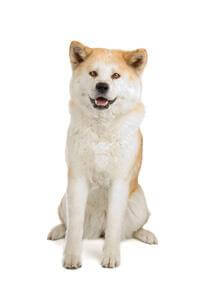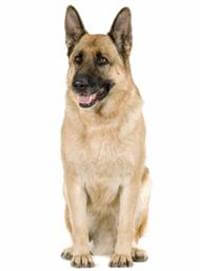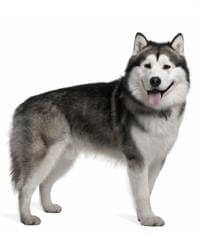
Akita overview
The Akita dog breed is known to be dignified and unique, given its ancient Japanese background. Akitas make extremely loyal pets that are protective of their families, with their bold and brave personality combined with a strong-willed nature. The Akita’s size and imposing appearance are what often strike people the most, since they have a thick double coat which can come in different colours and requires regular grooming.
In terms of their suitability as pets, they will need to be well-socialised as pups to be around children and other pets, as well as continued and consistent training. It’s also important to consider an Akita’s health as certain hereditary conditions can be common in this breed, which we talk about later. However, generally the Akita's life span is between 10-15 years.

Thinking about adopting an Akita? Check your local shelter first!
While it’s tempting to look specifically for an Akita dog if that’s the breed you’ve decided on, you may want to consider adopting a dog from a local shelter instead. You could still find the breed you’re looking for, but if not, you’ll still have a rewarding experience rescuing a dog in need. Dogs in shelters are looking for loving homes, and you could change their life by helping them.
Shelters often provide health screenings and behaviour assessments for their dogs, so you can bring home a dog that is healthy and vaccinated. You’d also be relieving the shelter so they can continue to help other animals in need.
There are also advantages to adopting a mixed-breed dog, and you could find a dog that is similar to the Akita’s temperament. Mixed breeds have a more diverse range of genes, which means they tend to have fewer hereditary issues than pedigree dogs. Their personalities are also varied, offering a unique but balanced mix.
Visit our adoption page to learn more about how to rescue a dog and find your new canine companion.
Akita characteristics: What makes them unique?
There are many characteristics that make the Akita unique. Its history is particularly significant since they developed in Northern Japan in the early 17th century. Akitas have been a long standing part of Japanese culture and tradition through myths and legends. Originally, Akitas were bred to hunt large game in packs, including wild birds and deer, as well as to guard their families.
An Akita’s temperament is what makes them distinctive from other breeds, since they are calm and collected, but form extremely deep bonds with their families, whom they serve and protect. They are also highly intelligent and receptive to consistent training. However, they do have an independent side, which can make training a bit more difficult.
In terms of an Akita’s size, there are some differences between the standard male and female Akita. Female Akitas weigh between 25-30 kg, while male Akitas weigh more at 32-39 kg. The Japanese Akita’s size is significantly less than the American Akita, which has a much larger build. There are also differences in coat colour, ranging from red, fawn, white, brindle, and pinto.
You may also find other variations with similar or commonly mixed breeds. For instance, Alaskan Malamutes have a similar build, Chow Chows have a bear-like appearance and Siberian Huskies boast a thick coat too. Similar to the Akita’s temperament, German Shepherds also share a strong sense of loyalty.
An Akita’s grooming and hygiene needs
The Japanese Akita’s size is influenced by their dense double coat, with the undercoat serving as insulation and the outer coat repelling dirt and water. Given their origin from northern Japan, their coat helped to protect them from colder weather. Akita’s coat type is soft and straight, and generally doesn’t require much maintenance; grooming once or twice a week is usually enough to keep their coat looking fresh and healthy. You can find out how much for dog grooming.
However, Akitas go through a process called ‘blowing coat’ twice a year, which is when their undercoat sheds heavily. During this time, you’ll need to brush regularly to avoid clumps of hair around the house, as well as matted fur. You can use an undercoat rake to help brush out dead hair and reduce the mess. In terms of bathing, an Akita only needs one every few months or as and when it’s needed to remove loose hair. However, you shouldn’t bathe your dog too often to avoid stripping their natural oils.
Akitas will also need their nails trimmed every few weeks so they don’t grow too long and cause pain and discomfort. Ear cleaning needs to be done regularly, especially since Akitas have thick fur around their ears that can trap debris. You should also brush your Akita’s teeth daily to prevent bad breath and build-up of plaque, and ensure good dental health.
An Akita’s behaviour and training needs
The Akita’s temperament is what makes it unique. With its dignified nature, Akitas are often quiet but alert, and they make loyal and protective pets that are very devoted to their families. However, their independent streak can make them strong-willed and stubborn. This may make your Akita come across as aloof when around unfamiliar people or animals.
Early socialisation and consistent training are really important for Akita dogs, given their history as hunters, which can make them quite territorial. For dog training, you’ll need to be calm and patient, using positive reinforcement techniques for behaviours. First, start with commands, and then continue obedience training as they get older. Use toys and dog treats to reinforce desired behaviours, and keep sessions short and engaging.
Some common behavioural challenges with an Akita’s temperament include being aggressive with other dogs (especially of the same sex), overprotective of family members, or dismissive of guests. However, with proper socialisation when they are puppies and exposure to different animals, environments, and people, you can establish important boundaries.
An Akita’s mental and physical stimulation
Given that Akitas are highly intelligent and strong dogs, they require plenty of mental and physical stimulation for their well-being. They’re not as energetic as some other dog breeds, but they will massively benefit from daily walks and can handle moderate exercises such as hiking. They also enjoy structured play with their owners to reinforce their bond.
Besides interactive play, it’s also important to maintain their mental health with other engaging activities such as puzzle toys and obedience training. Akitas enjoy a challenge, and by channelling this in the right way, you can avoid unwanted behaviours.
If an Akita doesn’t have enough stimulation, they may become frustrated or anxious and exhibit destructive behaviours like barking, chewing, and digging. It can also become difficult to correct bad habits that may form. It’s important to provide a routine for your Akita’s day for harmony in the house.
Does an Akita bark a lot?
No, Akitas don’t tend to bark a lot since it’s in their nature to be quiet and reserved. The Akita may be more vocal in unfamiliar situations or around strangers, which makes them great watchdogs, but they don’t bark excessively. If your Akita dog is barking a lot, they may be bored or anxious due to being understimulated, uncomfortable, or unsatisfied.
An Akita’s nutritional requirements
Since an Akita’s size is large, it’s essential to meet their nutritional needs accordingly. Akitas should be fed a complete and balanced diet, tailored to their life-stage and life-style to deliver all of the nutrients they need in just the right amounts in order to maintain their strong muscular build, energy levels, coat health and digestion. Glucosamine and omega-3 fatty acids can support your Akita’s joints as they get older too.
There are also vitamins and minerals that are beneficial to your dog, including the Pedigree® Multivitamins. These help address different concerns, including digestion, joint care, and immunity, covering all the necessary nutrients. It’s also best to avoid human foods, especially dairy items like milk, which can cause gastrointestinal upset. In terms of treats, you’ll want to stick to the recommended amount, as too many can lead to obesity, strain their joints, and affect long-term mobility in the Akita’s life span.
Are Akitas a good family dog?
Akitas are affectionate family pets with a deep sense of loyalty. They form strong bonds with family members and can really love their owners. However, their protective nature can be challenging at times. If they’re properly socialised from a young age, Akitas can be gentle around children, calm around other pets, and respectful to family members. But it’s best to still supervise interactions, given the Akita’s larger size and potential intolerance of rough handling.
In terms of adaptability to different living environments, Akitas can adjust to large flats as well as homes with secure gardens, as long as they receive enough mental and physical stimulation. They prefer quieter homes and enjoy a structure to their day. Considering the Akita’s life span as well, this breed can make great family dogs, as long as they’ve had the right upbringing, consistent training, and clear boundaries put in place.
Akita breeding and finding a responsible breeder
When looking for a dog to bring home, it’s essential to be informed about responsible breeding practices so you can find an ethical breeder. These breeders will prioritise the health and temperament of their dogs, rather than appearance and profit. They adhere to the breeding standards, which can help reduce the likelihood of hereditary health conditions. It’s also important that breeders ensure dogs are properly socialised from a young age.
To find a good dog breeder, make sure to do thorough research and find a registered breeder that is known or well-reviewed. It’s better to visit the breeder in person so you can see if the environment is clean and safe, as well as checking health records for the dog. Across the Akita’s life span, they can be prone to certain conditions, and your breeder should have had a health screening completed.
When selecting an Akita puppy, you can see if they are in good health by checking if their eyes are clear and their coat is shiny. The Akita’s temperament should also be calm but confident, rather than aggressive or anxious. This helps ensure you’re bringing a healthy and happy dog home.
Akita dogs can be a wonderful addition to your family since they value companionship and are dedicated to their owners. However, given their wilful nature, they are better suited to owners with experience in dog training. If you’re looking for a different family dog, check out our breed finder for guidance. But if you want to truly enrich your life while finding a canine companion, consider adopting a dog instead.






